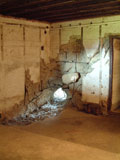Picauville
Crisbecq, Azeville and Foucarville

German Crisbecq Battery.

Azeville, Casemates.
Crisbecq, German Battery
I highly recommend this visit. Take an hour or so to discover an amazing number of bunkers, which were buried for years after the war and finally exhumed by the landowner. This fortified complex contained casemates housing 210-mm guns which easily reached Utah Beach. Despite shelling from large-caliber guns and repeated infantry assaults, the battery held out until 12 June, all the while harassing landing operations. It was the one major battery in the lodgement area that actually became a factor in the post-D-Day battle.

Azeville, German Battery
The casemates, that housed four French 105-mm guns, flank the road just before you enter the village. The casemates are not open to visitors.
After withstanding attacks from the 22d Infantry for two days, the battery surrendered after a flamethrower, triggered by Private Ralph G. Riley, set off ammunition inside one of the casemates. Riley was awarded the Silver Star for his single-handed attack.
Foucarville, Prisonners Camp No. 19

By the end of June a camp for 20,000 German prisoners was established, which finally was extended to 40,000 men including 18 Generals and 6 Admirals. The Camp was commanded by Lt. Col. Kennedy.
This CCE was almost a town, with hospital, prison, churches, theatre, pub, bakery etc... The total surface was 306 acres including 48 acres of garden, circumference 3.2 miles, roads and side walks 3.9 miles, barbe wired fences 180 miles, water pipe lines 24 miles, high voltage line 19 miles, communication lines 64 miles, phone installed 275, squad tents 1100, pyramidal tents 370, 50 kitchen... Unfortunately nothing subsists today apart a barn made with field stones use as explosive storage and use as private living home today.